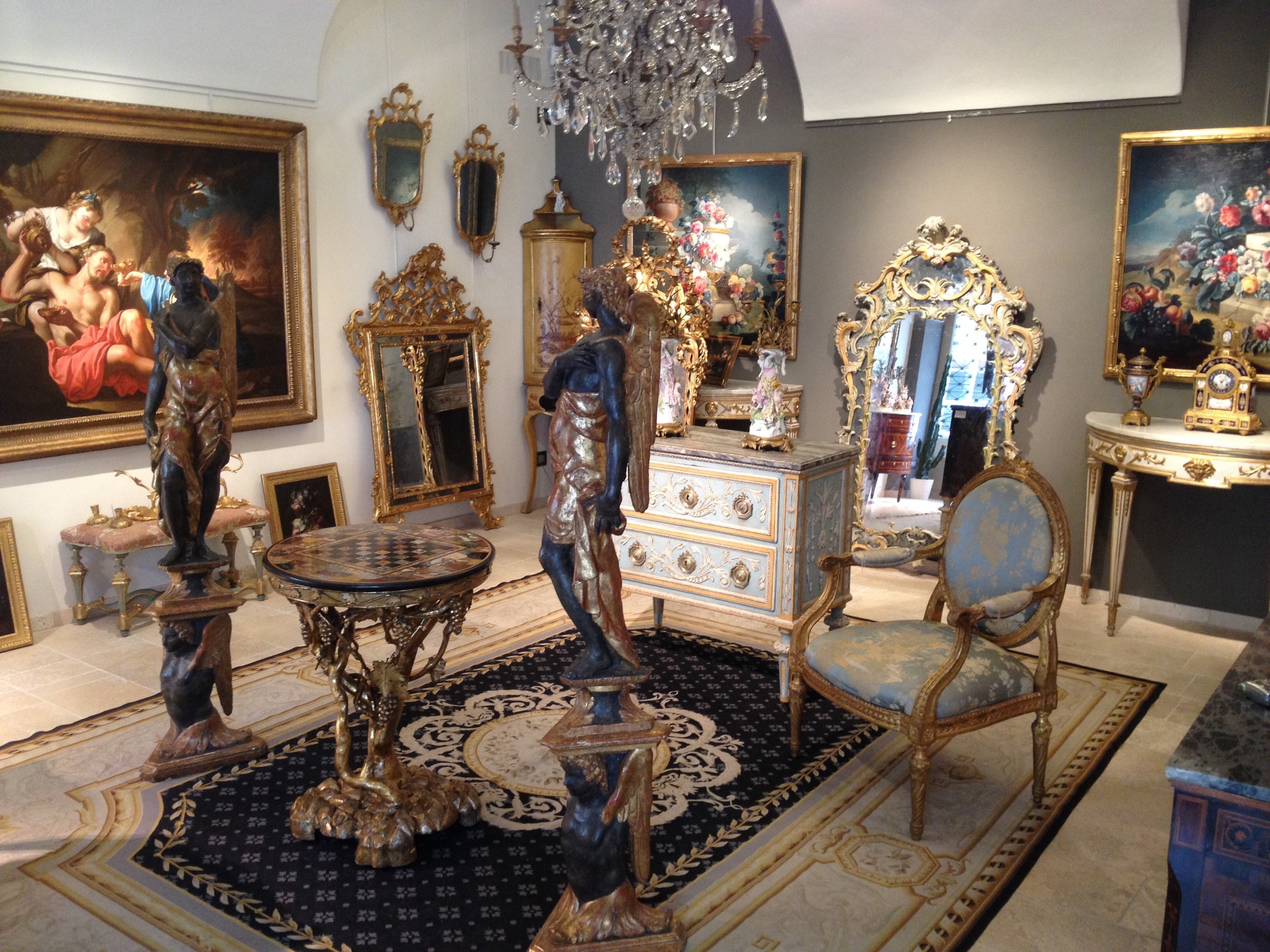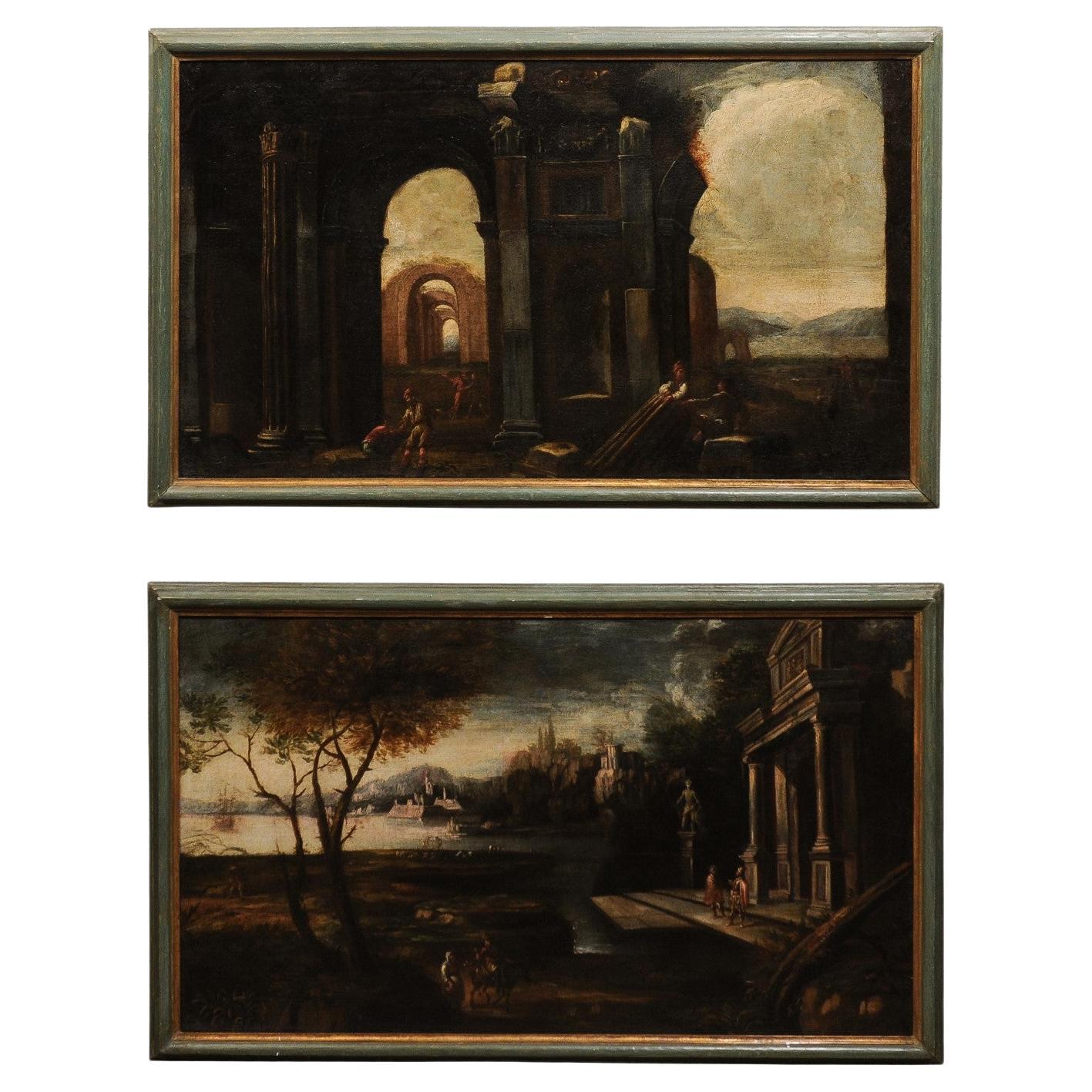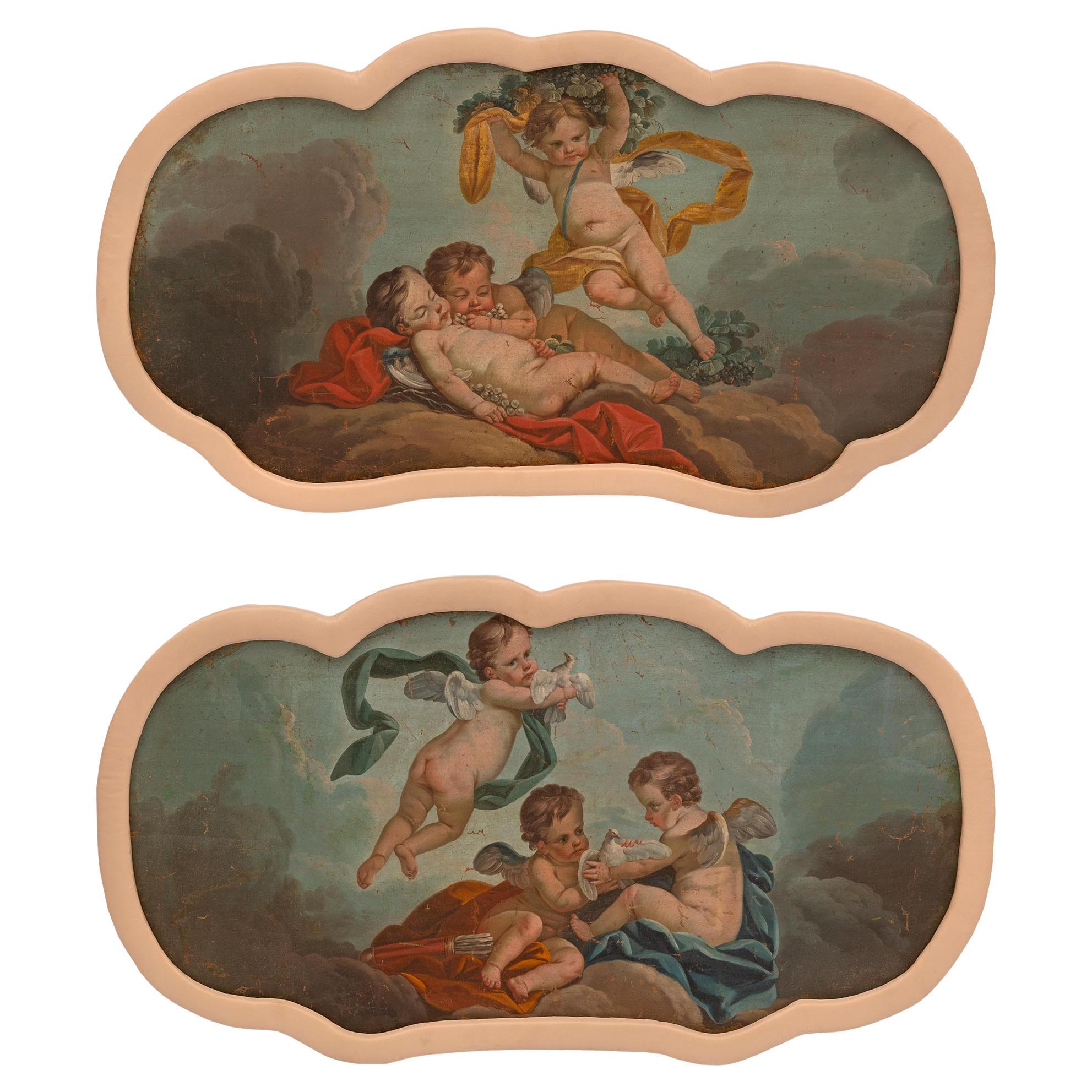Items Similar to 18th Century, Italian Pair of Oil on Canvas Paintings by Francesco Simonini
Want more images or videos?
Request additional images or videos from the seller
1 of 18
18th Century, Italian Pair of Oil on Canvas Paintings by Francesco Simonini
About the Item
Francesco Simonini (Parma, 16 June 1686 - Parma, 1766)
“The rest of the soldiers” and “The march of soldiers”
oil on canvas
The very fine paintings, attributable to the painter Francesco Simonini, depict two different moments related to the vein of battles and military themes: “The rest of the soldiers” and “the march of soldiers”.
In one of the paintings you can see on the right in the foreground some soldiers sitting and playing dice, while next to a couple banquets with wine. The scene takes place outdoors, in a countryside, next to a rocky promontory on the top of which dominates a tower. On the left is a couple of gentlemen in noble clothes and a beggar hands them a hat as a sign of alms. In the background, are described other characters including soldiers on horseback and wayfarers, while in the distance you can see a city and a high bell tower. The horizon is outlined by rocky reliefs and other small villages. The blue sky is marked by some white clouds and fluffy.
The other painting depicts, in the lower half of the canvas, a military deployment in which several mounted soldiers are gathered and ready to march. In the distance there is a city with walls and towers beyond which a prominent mountain serves as a fifth to the scene. A few clouds brighten the clear sky.
The genre of painting battles and scenes closely related to the conflict, including the pay and support of troops, advancements and the March of soldiers, found great success in the collections of the Italian and European nobility of the seventeenth and eighteenth centuries. Battle painting was a popular genre and was requested above all by the great aristocratic families, such as the Medici in Florence and the Estensi in Parma, who loved to furnish their living rooms with the paintings of the most important "battallists".
Among these, Francesco Antonio Simonini (1686-1766) distinguished himself, who, after having worked in Parma, Rome, Florence and Bologna, realized most of his works in Venice.
The couple of paintings in this study can be returned with reasonable conviction for stylistic comparison, to the corpus of works of this famous Italian painter.
[…]
His particular style, characterized by rapid brushstrokes and the use of bright colors, is formed mainly under the influence of the Venetian school. Characteristic of his painting is also the tendency to realize elongated and sinuous figures, the attention to the particular landscape and architectural style also Classic, the depth of the landscape that is lost to infinity, the almost indefinite horizon line for the confusion of heaven and earth, the drama and realism in which you notice the influence of Salvator Rosa. It is therefore possible to say that Simonini was able to reinterpret the lesson of his predecessors, enriching it with a Venetian-style coloring, acquired during the long stay in the lagoon city, and with a free and frayed touch, which gives lightness to the composition.
From the stylistic comparison between the works in question and those returned to the catalogue of Francesco Simonini are evident the peculiarities of his painting. The elegant elongated figures treated with sure and quick brushstrokes, the way in which the landscape and the sky are described, the chromatic palette are in fact completely comparable to many other canvases by Simonini. The same applies to the use of white, which the artist expertly uses, creating illuminations and points of light useful to give three-dimensionality to his figures and made material, such as the sparkle of weapons and the soft plumage of hats.
The print of an etching, preserved in Naples and taken from a drawing by Francesco Simonini, clearly shows a composition quite similar to that present in one of the two canvases in question. The mirror vision of the subjects derives from the printing technique itself: the engraving on copper of the drawing takes place on the plate, after which it is upside down and printed on paper producing a symmetrical image.
- Attributed to:SIMONINI (Artist)
- Dimensions:Height: 20.48 in (52 cm)Width: 27.56 in (70 cm)Depth: 2.37 in (6 cm)
- Style:Baroque (Of the Period)
- Materials and Techniques:
- Place of Origin:
- Period:
- Date of Manufacture:Early 18th Century
- Condition:
- Seller Location:IT
- Reference Number:1stDibs: LU4405219623392

About the Seller
5.0
Gold Seller
These expertly vetted sellers are highly rated and consistently exceed customer expectations.
Established in 1980
1stDibs seller since 2019
41 sales on 1stDibs
Typical response time: 1 hour
- ShippingRetrieving quote...Ships From: Italy
- Return PolicyA return for this item may be initiated within 7 days of delivery.
More From This SellerView All
- 18th Century, Pair of Italian Still Life Painting, attr. to Francesco LavagnaBy Francesco LavagnaLocated in ITFrancesco Lavagna (Italy, Naples 1684-1724) Pair of paintings depicting Still Life composition of flowers and watermelon and garden in the background The paintings, beautifully mad...Category
Antique Early 18th Century Italian Baroque Paintings
MaterialsCanvas
- 18th Century Italian Oil on Canvas Painting with Battle by Antonio CalzaBy Antonio CalzaLocated in ITAntonio Calza (Italy, Verona, 1653-18th April 1725) "Battle between Christian and Turkish cavalry with castle" The painting depicts a bloody battle between Christian and Turkish cavalry. Characterized by dynamism, intensity of color and light, the main scene occupies the lower horizontal section of the canvas, optically interrupted by the black fumes of the shots from which emerge, on the left, the towers of a fortress. On the right, in the distance you can see the combat in progress in the countryside, beyond which you can see the pale presence of hills that create a fifth, marking the horizon. To frame the scene contributes to the left, against light and in the foreground, a portion of the wall. The painter, however, introduces a horse on the ground, of which we see only the back, a ruse to involve the observer making him become active and participate in the scene. In the foreground, lifeless bodies, wounded horses and, scattered on the ground, weapons and a drum enhance the drama of the clash. The excitement and expressive force, the intense chromatic range attentive to the conditions of light and the fine brushstrokes, decisive and dramatic, suggests the attribution to Antonio Calza, one of the most important painters of battles of the seventeenth century, excellent student and continuator of the greatest interpreter of the genre, Jacques Courtois called il Borgognone (Saint-Hyppolite 1621 - Rome 1676). Il Borgognone, although not having had a real school or direct students, places itself as a primary reference point by the Italian and foreign "battaglisti". The genre of battle painting found great success in the collections of the Italian and European nobility of the seventeenth and eighteenth centuries. The battles of the Italian Renaissance, in which the scene converged towards a precise protagonist, evolve towards a type of combat "without hero". The bloody realism of the details and the dynamic development of the narrative confuse the figure of the protagonist, when present, to give importance to the swirl of horses and armed fighters, among which, moreover, does not emerge a winner. The certain documents relating to the life and movements of Antonio Calza are scarce; it was equally difficult to reconstruct, from the critics, a catalogue of autograph works. Through paintings in private collections, in museums and paintings passed on the antiques market it has been possible to identify a copious corpus of works that can be traced back to his hand. The work of art historians, together with that of antique dealers, in conferring proper attributions in order to best outline the figure of Calza, continues but studies are still in progress. In this sense, the work of Giancarlo Sestieri should certainly be noted, who investigated the artistic production of the battaglisti and Calza, thus allowing the comparison of the numerous photographic works reported, to identify and recognize the stylistic qualities that distinguish the corpus of paintings assigned to him today. Antonio Calza was born in 1653 in Italy, in Verona and in 1664 he entered the school of Carlo Cignani in Bologna, dedicating himself to painting battles and landscapes. He then perfected in Rome, where he knew the works of the then undisputed head of the sector, Jacques Courtois called the Burgundian. In 1675 he returned to Verona and married an 88-year-old widow who, dying, left him a rich inheritance. Much appreciated by the nobility and the bourgeoisie, he received numerous commissions. Bartolomeo Dal Pozzo (Le Vite de' pittori, de gli scultori et architetti veronesi, 1718) praises "three great paintings of battles...Category
Antique Late 17th Century Italian Baroque Paintings
MaterialsCanvas
- 18th Century, Italian Oil on Canvas Painting with Landscape with RuinsLocated in IT18th century, Italian oil on canvas painting with landscape with ruins Measures: only the canvas cm W 97.5 x H 108; with the frame cm W 103.5 x H 114 x D 5 The fine oil on canv...Category
Antique 18th Century Italian Baroque Paintings
MaterialsCanvas
- 18th Century, Italian Oil on Canvas Still Life by Pietro NavarraLocated in IT18th century, Italian oil on canvas still life by Pietro Navarra Oil on canvas, canvas measures: cm H 103 x W 164, framed measures...Category
Antique 18th Century Italian Baroque Paintings
MaterialsCanvas
- 18th Century, Italian Still Life Painting Attributed to Francesco LavagnaBy Francesco LavagnaLocated in ITFrancesco Lavagna (Italy -Naples 1684-1724) "Still life with flowers and watermelon and hermas with garden in the background" The painting, beautifully made and in good condition, d...Category
Antique Early 18th Century Italian Baroque Paintings
MaterialsCanvas
- 18th Century, Italian Painted with Still Life by Francesco LavagnaBy Francesco LavagnaLocated in IT18th Century, Italian painted with still Life by Francesco Lavagna. The fine and imposing painting, accompanied by a frame in carved and gilded wood, depicts a sumptuous composition...Category
Antique Early 18th Century Italian Rococo Paintings
MaterialsCanvas
You May Also Like
- 18th Century Italian Antique Oil on Canvas Painting Saint Francesco SaverioLocated in Casale Monferrato, ITBeautiful antique Italian oil painting on canvas. Excellent pictorial quality great attention to detail. Italian school of the 18th century. Not signed. A beautiful religious painting Saint Francesco...Category
Antique 1750s Italian Paintings
MaterialsCanvas
- Italian painting, oil on canvas, 18th C.Located in Aalsgaarde, DKItalian painting, oil on canvas, 18th centuryCategory
Antique 18th Century Paintings
MaterialsWood, Paint
- Pair of Large Framed 18th Century Italian Oil on Canvas PaintingsLocated in Atlanta, GAPair of Large Framed 18th Century Italian Oil on Canvas Paintings of Classical ScenesCategory
Antique 18th Century Italian Paintings
MaterialsCanvas
- 18th Century Oil on Canvas Italian SchoolBy Carlo MarattaLocated in Marseille, FRPainting with probably biblical Italian school characters End of the 17th beginning of the 18th century unsigned carrying a Carlo Maratta cartouche of in...Category
Antique Early 18th Century Italian Baroque Paintings
MaterialsCanvas
- Pair of French 18th Century Oil on Canvas PaintingsLocated in West Palm Beach, FLA beautiful and most charming pair of French 18th century oil on canvas paintings. Each most decorative and colorful cloud shaped painting disp...Category
Antique 18th Century French Paintings
MaterialsCanvas, Wood
- Pair of 18th Century Italian Oil PaintingsLocated in Houston, TXPair of Italian School Paintings from the 18th Century. " Allegory of Summer and Autumn" Oils on canvas. In simplistic black frames with slight gilding.Category
Antique 1780s Italian Paintings
MaterialsPaint, Canvas
Recently Viewed
View AllMore Ways To Browse
18th Century Baroque Painting
Italian Baroque Painting
Pair Of European Paintings
Heaven Antique Furniture
Italian Baroque Canvas
Italian Baroque Oil Paintings
Nobility Painting
Pair Of Wall Relief
18th Century Oil Paintings Small
Pair Of Early 18th Century Blue
Italian Military
A Pair Of Walls Reliefs
18th Century Military
Small Oil Painting Pair
Small Pairs Of Oil Paintings
Pair Of Painted Italian Mirrors
18th Century Italian Wall Plate
Mirror With Etching





